| Up a level | |||||||||
 |
 |
 |
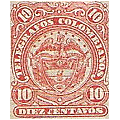 |
 |
 |
 |
 |
 |
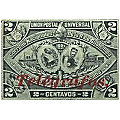 |
| Argentina | Bolivia | Chile | Colombia | Costa Rica | Cuba | Dominican Rep. | Ecuador | El Salvador | Guatemala |
| Up a level | ||||||||||
 |
 |
 |
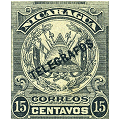 |
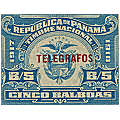 |
 |
 |
 |
 |
 |
 |
| Honduras | Mexico | Morocco | Nicaragua | Panama | Paraguay | Peru | Philippines | Puerto Rico | Uruguay | Venezuela |
Colombia.
I have been shown pages from a specialised catalogue (in Spanish and also printed in 1982) called "CATALOGO ESPECIALIZADO L.T." that
is normally used by Colombian collectors. (can anyone supply more information? ISBN ?)
It is arranged rather differently to Hiscocks' book, making no reference to different dies, and using 'issue numbers' for the different series of stamps.
I will attempt to merge/cross reference the two approaches and add a column labelled 'CE#' for the reference number in that catalogue.
Before 1886, 'CE' lists 5 series of stamps against 2 series listed by Hiscocks, but used stamps are not priced.
'CE' shows illustrations against each series, but is seemingly unaware of any die differences,
making the distinctions instead on the basis of colour and paper, without dated copies. Truly amazing!
Steve Hiscocks recognised that the telegraph stamps were a challenge. I have read all I could find on these issues, but none matched the facts.
I realize that I am new to this and the novice should not challenge acknowledged experts, but I feel I have to. I state my case below. Challenges are welcome.
Printed in Bogotá by León F. Paredes and Demitrio Villaveces.
'CE' lists a series for each year up to 1886.
My thanks to David Eraso Alvear of Davidcol on delcampe for help with this.
I will list their first six series here, then attempt to reconcile them with Hiscocks when/where I can.
For each series, 'CE' illustrates 4 out of the 5 stamps.
Where I can identify the Hiscocks type in these, I will give it.
It starts (page 231) with some notes that I will attempt to translate:
| 1. Telegraph stamps are a true philatelic mode, since they were required for a form of social communication. |
| 2. In the early times of our philately postage and telegraph stamps were both collected. The second form has fallen into disuse because of the lack of them, and because they were discontinued. |
| 3. Our telegraph stamps were in effect for 25 years, from 1881 to 1906. |
| 4. Among these there are no known fakes. |
| 5. The major part of our series of telegraph stamps are imperforate. Perforated are scarce. |
| 6. They were printed in Bogotá by León F. Paredes and Demitrio Villaveces using monochrome lithography, on various papers, white or colored, with a thickness characteristic of the time. |
| 7. The cancellations were usually in indelible black pen. Some however were also cancelled with rubber using black, purple or blue ink: a) Stamped "FRANCA" in pointed oval, black ink. b) Stamped monogrammed "TN" inside a double oval with blue ink (about the 1886 issue). c) Violet cancel with the word "cancelada" within double circle (about the 1896 issue). |
| 8. Viñetas (bullets). [seals] Early in the 20th. century we find that to seal telegrams 'bullets' were used without any face value. There are three types of them: Type I In red and chestnut imprint 'Lit. Nacional'. Type II In blue imprint 'Lit. Nacional'. Type III In brown tones imprint 'Lit. Colombia Bogotá '. |
1881 (1st. issue). White paper. No watermark. Imperf.

| CE# | Hisc. | Type. | 1881 Description | Mint | Used |
|---|---|---|---|---|---|
| 1 | H1 | 1 | 5c light violet (type II illustrated !) | 2.00 | - |
| 2 | H2 | 2 | 10c green (type I illustrated) | 3.00 | - |
| 3 | H3 | 3/6 | 20c red (type I illustrated) | 4.00 | - |
| 4 | H4/H4a | 4/10 | 50c gray-violet (not illustrated) | 5.00 | - |
| 5 | H5 | 5 | 1p chestnut / straw (type III illustrated !) | 15.00 | - |
1882 (2nd. issue). Blued and transparent paper. No watermark. Imperf.

| CE# | Hisc. | Type. | 1882 Description | Mint | Used |
|---|---|---|---|---|---|
| 6 | H1b | 1 | 5c violet (type I illustrated) | 2.00 | - |
| 7 | H2a | 2 | 10c dull green (type II illustrated) | 3.00 | - |
| 8 | H3a | 3/6 | 20c strong red (not illustrated) | 4.00 | - |
| 9 | H11 | 4/10 | 50c dark purple (type ? illustrated) | 5.00 | - |
| 10 | H12 | 5 | 1p black / green (type II illustrated) | 15.00 | - |
1883 (3rd. issue). White paper. No watermark. Imperf.

| CE# | Hisc. | Type. | 1883 Description | Mint | Used |
|---|---|---|---|---|---|
| 11 | ? | 1/7 | 5c ultramarine (type II illustrated) | 2.00 | - |
| 12 | H2 | 2 | 10c green (type I illustrated) | 3.00 | - |
| 13 | H3 | 3/6 | 20c carmine (type I illustrated) | 4.00 | - |
| 14 | H11 | 4/10 | 50c purple (not illustrated) | 5.00 | - |
| 15 | H12 | 5 | 1p black / green (type I illustrated) | 15.00 | - |
1884 (4th. issue). Bluish paper. No watermark. Imperf.
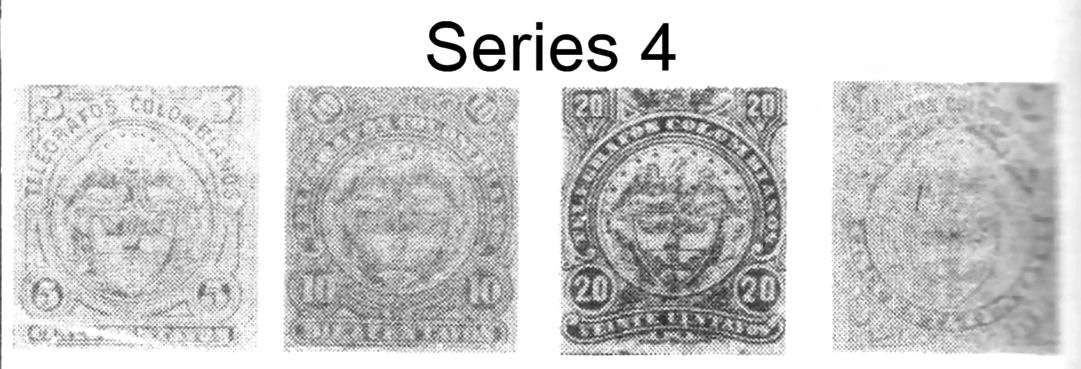
| CE# | Hisc. | Type. | 1884 Description | Mint | Used |
|---|---|---|---|---|---|
| 16 | H7 | 1/7 | 5c blue (type I illustrated) | 2.00 | - |
| 17 | H8a | 2/8 | 10c pink (type I illustrated) | 3.00 | - |
| 17a | ? | perf.12 | 4.00 | - | |
| 18 | H10a | 3/6 | 20c chestnut (type I illustrated) | 4.00 | - |
| 19 | H11 | 4/10 | 50c violet (type ? illustrated) | 5.00 | - |
| 20 | H5 | 5 | 1p chestnut / yellow (not illustrated) | 15.00 | - |
1885 (5th. issue). White paper. No watermark. Imperf.

| CE# | Hisc. | Type. | 1885 Description | Mint | Used |
|---|---|---|---|---|---|
| 21 | H7 | 1/7 | 5c light blue (type I illustrated) | 2.00 | - |
| 22 | H8/14 | 2/8 | 10c carmine (type II illustrated) | 3.00 | - |
| 23 | H10/H15 | 9? | 20c chestnut (type III illustrated) | 4.00 | - |
| 23a | ? | perf.12 | 4.00 | - | |
| 24 | H11 | 4/10 | 50c strong violet (not illustrated) | 5.00 | - |
| 25 | H6 | 5 | 1p black / yellow (type I illustrated) | 15.00 | - |
1886 (6th. issue). Bluish paper. No watermark. Imperf.

| CE# | Hisc. | Type. | 1886 Description | Mint | Used |
|---|---|---|---|---|---|
| 26 | H13 | 7 | 5c dark blue (type I illustrated !) | 2.00 | - |
| 27 | H14 | 8 | 10c red-orange (type I illustrated !) | 3.00 | - |
| 27a | ? | perf.12 | 3.00 | - | |
| 28 | H15a | 9 | 20c chestnut (not illustrated) | 4.00 | - |
| 28a | H15 | reddish chestnut | 4.00 | - | |
| 29 | H16 | 4/10 | 50c violet (type ? illustrated) | 5.00 | - |
| 30 | H6 | 5 | 1p black / straw (type I illustrated !) | 15.00 | - |
The illustrations do not make sense in the order given !
Here is a table to show what I mean.
| Series | Year | 5c | 10c | 20c | 50c | 1p | Paper |
|---|---|---|---|---|---|---|---|
| 1 | 1881 | type II, light violet | type I, green | type I, red | gray-violet | type III, chestnut / straw | white |
| 2 | 1882 | type I, violet | type II, dull green | strong red | dark purple | type II, black / green | blue and transparent |
| 3 | 1883 | type II, ultramarine | type I, green | type I, carmine | purple | type I, black / green | white |
| 4 | 1884 | type I, blue | type I, pink | type I, chestnut | violet | chestnut / yellow | bluish |
| 5 | 1885 | type I, light blue | type II, carmine | type III, chestnut | strong violet | type I, black / yellow | white |
| 6 | 1886 | type I, dark blue | type I, red-orange | chestnut or red-chestnut | type II ? violet | type I, black / straw | bluish |
The ones in pink are unknown stamps, and no 20c type II are illustrated.
I thought at first that it was possible that the illustrations got mixed up after being converted to half-tones.
Without checking the dies, only the 20c type III would have been easily recognisable, but then
that is used to illustrate series 5 which also shows type I of the 5c and 1p. stamps !
I have not been able to rearrange them to make a sensible progression. Here is my best re-ordering of the illustrations:
| Series | Year | Was | 5c | 10c | 20c | 50c | 1p | Paper |
|---|---|---|---|---|---|---|---|---|
| 1 | 1881 | 4 | type I, light violet | type I, green | type I, red | gray-violet | chestnut / straw | white |
| 2 | 1882 | 6 | type I, violet | type I, dull green | strong red | type ? dark purple | type I, black / green | blue and transparent |
| 3 | 1883 | 3 | type II, ultramarine | type I, green | type I, carmine | purple | type I, black / green | white |
| 4 | 1884 | 1 | type II, blue | type I, pink | type I, chestnut | violet | type III, chestnut / yellow | bluish |
| 5 | 1885 | 2 | type I, light blue | type II, carmine | chestnut | type ? strong violet | type II, black / yellow | white |
| 6 | 1886 | 5 | type I, dark blue | type II, red-orange | type III, chestnut or red-chestnut | violet | type I, black / straw | bluish |
I prioritised the order of the 10c and 20c as the clearest types. The 5c though is clearly wrong, but it gets rid of the unknown stamps.
I honestly don't know the sequence of the 1p types, but would have thought it would not turn back on itself.
Perhaps the illustrations were only intended to show the general types and were not actual examples.
The cynical side of me says that when creating a catalogue, decisions have to be made about the ordering, even in the absence of evidence.
I also have to say that I have not yet seen any of these on 'blued' paper except for this suspect item:


I do not know if the paper colouring is genuine. Series 6 perhaps ?
Perhaps I just haven't seen enough examples yet. scans invited.


